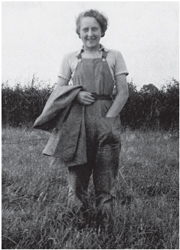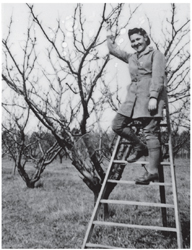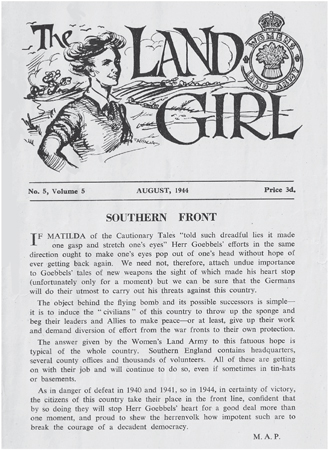Essex Land Girls (14 page)
Authors: Dee Gordon

Her story was in the
Loughton & District Historical Society Newsletter
in the autumn of 2005.
Gladys Kempton and Daphne Dimmick
In August 1942, the
Essex Chronicle
gave an account of the ploughing up of the rough land at Nazeing Common. The cricket club ground had already been ploughed, with the pavilion serving as a tool shed. It appeared that 21-year-old Land Girl Gladys Kempton, a former knitting machinist from Westcliff-on-Sea, was the first ‘woman excavator driver in Essex, engaged in ditching work on the outskirts of the common’ for twelve hours a day. She shared a caravan with Daphne, for which they were looking for a ‘wireless set … so they could put their clock right and wouldn’t be late for work’ if someone ‘could oblige’! The girls operated giant diggers and the land was prepared for barley, wheat and root crops.
In Vita Sackville-West’s 1944 book of her experiences in the Land Army – which gave an overview of the service – she mentions Nazeing Common’s ‘rough, thistly ground, bumpy with emmet-hills and of no practical use to anybody. A 21-year-old ex-knitting machinist and a 24-year-old ex-typist, living together in a caravan, are responsible for the excavator on this particular track. Truly the war has precipitated young womanhood into some unexpected jobs.’
B.D. Fitzgerald
In the November 1944 issue of
The Land Girl
, ‘B.D.’ from Essex gave an insight into a day picking apples (see p.6, accessible online at
www.womenslandarmy.co.uk
):
‘What’s the weather like?’
‘Not raining now but “gum booty”.’
And so for a day’s apple picking attired in sou’westers and macs – a day spent wading through the mud that the tractor churns into huge puddles as it carts boxes of wet apples, tying pieces of string round your wrists to stop those icy trickles of rain up your arms, carrying boxes that seem twice as heavy because they are so damp – and an evening drying muddy clothes.
How different when the answer is ‘Glorious!’
There are huge jokes about practically nothing at all as we ride up to the orchard behind the tractor, a pleasant break for elevenses, cheerful discussions as picking buckets are filled – a day flies by as we strip the trees. The apples are exquisitely coloured: James Grieves, juicy, easily bruised, with a pale green to deep orange tint; rich red Worcesters; Monarchs, green and delicately tinted with pink; Cox’s Orange Pippins, sunrise and sunset coloured and lastly, Bramleys, which rely on taste and not appearance. Then, long before I have written all the letters and darned all the socks I should, it is time for bed.

‘M. Geraghty’ apple picking at Tiptree Fruit Farm. (Courtesy of Tiptree Museum)
Nola Bagley
In the wonderfully encyclopaedic
We Wouldn’t have Missed it for the World: the Women’s Land Army in Bedfordshire 1939–1950
,
there is a reference to Brightlingsea girl, Nola, joining the WLA with a friend, Jean White:
They were both sent to a market garden farm at Margaretting, near Chelmsford. Their first job was to hoe, then pick out shoots from tomatoes. Tomato plants stain the hands terribly yellow which is hard to get off and their hands were soon blistered. They had so many varied jobs that they ached somewhere different every day. They found themselves using Sloan’s liniment every night and must have reeked of the stuff. Sometimes they felt they were going to die with the pain and discomfort.
Ivy Cox
This is an interesting insight into Ivy’s working day, featured in
A History of Mark Hall Manor:
We worked in what they call gangs. If a farmer wanted extra help, a gang of six or maybe ten girls would go out on a lorry and do whatever was needed. Bean picking – that was nice – or lifting sugar beet. On frosty mornings, you’d pull them up. They’d been ploughed up so they were loose. We used to bang them together and they were often wet. Horrible! And ditching. I liked ditching. That was a nice job. You could see what you’d done. On wet days we were often paddling in water. Sometimes it could be falling down with rain at seven o’clock in the morning but we had to go out till eleven. If it was still raining hard then, we could go ‘home’.
Land Girls from Mark Hall in Harlow worked mainly for Mr Soper at New Hall, Mr Foulds at Dorrington Farm, Rye Hill, a potato farm on Nazeing Hill, or on the Arkwright Estate.
Molly Brankin
When 20-year-old Molly joined the WLA in 1939, she was working on her father’s farm in Northern Ireland, but ended up in a milking shed in Essex. She was interviewed for the
Essex Chronicle
(1 May 1942) while milking ‘Freda the Fourth’, and the reporter described Molly as ‘dark-haired and bright-eyed … and cheerful’. Incidentally, girls who were involved in milking were usually also involved in grooming the cows with a ‘curry comb’ to remove mud and dirt, something not all cows appreciated.
Rosa Hawes
From Suffolk and with experience of working the land, Rosa also features in the 1 May issue of the
Essex Chronicle
. Described as ‘twenty-five, small and dark, with a sun-tanned face and bright eyes’, she had received a year’s training from a shepherd and ‘works at a farm at Maldon [since 1939] … looking after 260 sheep which had 300 lambs between them this year … so far’. She had to ‘beware of the blue fly which gets into a sheep’s wool, and that means combing through the coat of each sheep’ and had to keep a constant eye on the flock ‘to make sure none fell over and landed on their backs with their legs in the air … [because they] can’t get up of their own accord’.
Joyce Clancy
Another East Ender, Joyce asked to be released from a munitions factory to join the WLA and was billeted in Layer-de-la-Haye (near Colchester) where she shared ‘a room in the large farm house with four other girls’. She ‘drove the tractor, milked the cows’ and was ‘sometimes sent to other local farms to help with the milking’. Her story appeared in the March 2014 issue of the
St Dominic’s Care Home Newsletter.
Gladys Levingbird
Gladys took on some heavy-duty work around Epping and Chigwell (see
All Muck, Now Medals
). ‘It was our job to move the equipment and caravan and bulldozer’ avoiding the tank-traps that had been laid. She was taught to drive a tractor and ‘had a provisional licence to take it on the road’.
Frances Ilines
Another Land Girl not afraid of heavy work; Londoner Frances also learnt to drive a tractor ‘with three days tuition’ – as well as a horse and cart – when at the Wilkins factory in Tiptree. She found herself ‘loading and carting bricks, paraffin and plumbing pipes. Some days [she] would have to cart coke from the railway track to the boss’s home, a fair journey, in a two wheeled tumbril.’ This was heavy work, leaving her ‘with a bad back’, although there were lighter duties ‘picking fruit and clearing blooms’ (reported in the
Programme for the Maldon Military and Veterans Show
, 2007).

A Land Girl identified as Joyce Crow at Tiptree Farm in 1942. (Courtesy of Tiptree Museum)
Eileen Burrows
Her experience working in a shoe shop in North London did not prepare Eileen for her first job as a Land Girl, ‘creosoting a 40ft chicken house’. Although she lived on a farm with no electricity at Little Totham and was ‘the only Land Girl’ in the vicinity, Eileen stayed in the WLA for eight years until 1948 (see
Little Totham, the Story of a Small Village
).
Grace Wiffen
An East Ender living in Dagenham, Grace’s story is on the Rayne village website. At 16, she joined the WLA, as she wanted to do ‘something for the war effort’ rather than working in a London shipping office, and the idea of working outdoors was attractive. Her parents were not too keen, and her first billet did not work out, but one in Hay Lane, Braintree, was an improvement, and she got stuck in with hedging work in Rayne until being offered work picking Brussels sprouts at Mr McGregor’s farm in the same area. The thought of less blisters was obviously attractive, and six Land Girls began working for Mr McGregor permanently, so she moved, with the other girls, to Rayne, to save a long bike ride. Apart from the sprouts, Grace ‘helped with the sheep at lambing time, and hoed sugar beet and kale, one acre at a time’. She worked on the threshing machine ‘on the chaff’ and led the horse when hoeing, apart from January and February which meant a return to hedging.
Hilda Anslow
The July 1999 issue of the
Friends of Epping Forest Newsletter
includes Hilda’s story of working as a Land Girl between 1943 and 1944 ‘at Carroll’s Farm [Waltham Abbey] … where we were told by the War Agricultural Committee to remove the hedge and young trees and plough the fields and grow corn. I helped the contractors to remove the trees and then I ploughed the fields. Whilst doing so, the tractor skidded down the bank and got stuck [and] overturned,’ but with the assistance of the farmer no harm was done.
Barbara Lodge
Barbara was originally a munitions worker at the Marconi factory in New Street, Chelmsford, producing vital military communications, but developed a skin complaint which proved a problem. As a result, she was reassigned to the WLA, aged just 16. A lot of her time was spent on a fruit farm at nearby Galleywood, and she met her future husband near there, in a local pub – but couldn’t tell her parents this because of her age. She was quoted in the
Essex Chronicle
of 24 November 2011 as being ‘so cold and tired’ at the end of the working day that she could ‘barely put pen to paper’ to write to her beloved Ron. However, some compensation was provided by ‘plenty of soldiers’ billeted nearby at Hyland’s Park, serving as dancing partners.
Anne MacLeod
In
The Land Girl
of August 1940, Anne wrote from Essex regarding the lambing season. ‘I got two pet lambs and instead of rearing them on a bottle I reared them on a heifer’, and she sent in a photo to prove it.

The Land Girl
,
August 1944. (Courtesy of Stuart Antrobus and
www.womenslandarmy.co.uk
)
Nancy Caton
Featured in
Clavering at War
, Nancy’s father was a farmer at Manuden in Essex, so she had some idea of what she was letting herself in for. In spite of the long hours, she enjoyed her stint in the Land Army at Uttlesford, feeding the chickens and pigs and helping to bring up the lambs who ‘followed her around’. There was also the potato planting, hoeing and ‘manure-spreading’ (the downside), and a rather daunting big boar ‘with large tusks’ that ‘none of the men would go near’ but who ‘loved to have its ears scratched’. The pigs had even more potatoes in their diet than the Land Girls.
Joyce ‘X’
Joyce (see Braintree District Museum archives) wrote of:
… a cider making plant at Witham. This was a large roof supported on four corners, no sides, open to the elements and it was always freezing cold. Boxes of apples were brought straight from orchards and tipped manually into the washing tank. The apples were then scooped out of the water to the top of the chute where two girls stood ready to push the apples into a grinder/masher. Another two girls waiting at the bottom had the job of spreading the mashed apples on to massive pieces of sacking and then fold the corners over, envelope fashion. A stack of about ten sacking envelopes was put under a press, this squeezed out all the juice. The dried apple mash was then thrown out on to a heap and the sacking reused. Thinking back, it wasn’t too hygienic, any twigs, leaves and spiders etc. that I had missed all went into the grinder.
